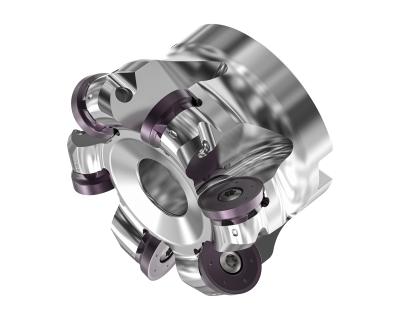
Seco Round 20 copy mills and inserts are designed for use in a wide range of applications, including face, side, slot, plunge. and ramp milling. The Round 20 inserts are compatible with cutter bodies from previous generations and provide additional performance in challenging materials, the company says.
The new Seco Round 20 cutters and inserts are suited for medium-to-rough milling in steel, stainless steels and heat-resistant superalloys and can also be productively applied to cast iron and hardened steels. The large-diameter inserts maximize material removal rates and offer a cost-effective means to generate an R10 mm radii with 20 mm round inserts.
The inserts can be indexed to four, six or eight positions, allowing users to match the insert consumption to the depth of cut being taken. This flexibility also means the new inserts integrate with existing cutter bodies that index to four or eight positions.
Through the use of insert shims and cassettes, users can maximize the life of Round 20 cutter bodies. With these options, manufacturers reduce the risk of damaging an insert pocket and eliminate the replacement cost and potential downtime that accompany unexpected tool breakage.
Round 20 features sixteen available cutter bodies with four shim options and three cassette options as well as thirty indexable cutting inserts.
Contact Details
Related Glossary Terms
- depth of cut
depth of cut
Distance between the bottom of the cut and the uncut surface of the workpiece, measured in a direction at right angles to the machined surface of the workpiece.
- gang cutting ( milling)
gang cutting ( milling)
Machining with several cutters mounted on a single arbor, generally for simultaneous cutting.
- milling
milling
Machining operation in which metal or other material is removed by applying power to a rotating cutter. In vertical milling, the cutting tool is mounted vertically on the spindle. In horizontal milling, the cutting tool is mounted horizontally, either directly on the spindle or on an arbor. Horizontal milling is further broken down into conventional milling, where the cutter rotates opposite the direction of feed, or “up” into the workpiece; and climb milling, where the cutter rotates in the direction of feed, or “down” into the workpiece. Milling operations include plane or surface milling, endmilling, facemilling, angle milling, form milling and profiling.
- ramp milling
ramp milling
Milling process in which the machine tool spindle is feeding simultaneously in an axial and radial direction.
- stainless steels
stainless steels
Stainless steels possess high strength, heat resistance, excellent workability and erosion resistance. Four general classes have been developed to cover a range of mechanical and physical properties for particular applications. The four classes are: the austenitic types of the chromium-nickel-manganese 200 series and the chromium-nickel 300 series; the martensitic types of the chromium, hardenable 400 series; the chromium, nonhardenable 400-series ferritic types; and the precipitation-hardening type of chromium-nickel alloys with additional elements that are hardenable by solution treating and aging.
- superalloys
superalloys
Tough, difficult-to-machine alloys; includes Hastelloy, Inconel and Monel. Many are nickel-base metals.

